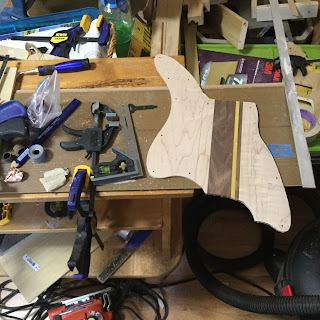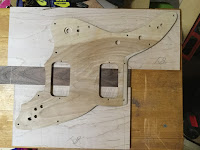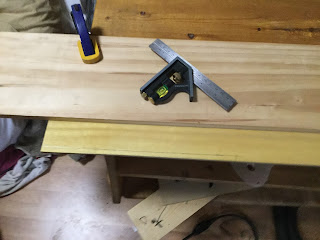Yes I changed my mind . . .
I never was exactly sold on the previous idea for the pick guard after seeing it, but wanted a wood guard and thought the colors were pretty and got carried away at the wood shop and . . . and thought a 2 piece pick guard would be 'cool' and ... and after seeing it with the maple thought that that might be a bit garish and ... and then was at a loss how to exactly connect the 2 pieces (blunt edge gluing of plastic to wood not being the best idea I ever came up with possibly ... epoxy or maybe urethane might do the job . . . on second though foaming urethane might not be the 'best' option, it will be problematic to get rid of off the top off the plastic.
ANYWAY
This is what I came home with . . . 1/4" thick (as was the other wood) one piece of walnut and one piece of curly maple. Not terribly impressed with the curlyness of the maple but I did some looking on the internet and it turns out that it's generally not THAT pronounced before finishing so maybe there is hope.
and there is a piece of yellow heart . . . Ok pieces layed out checked twice so ready for cutting . . . it IS a mitre box saw but, well it's a CHEAP miter box saw and it probably won't be around much longer. IT IS NOT STRAIGHT , that doesn't matter much here but for some other projects ... ugghhhh
And here it is lined up . . . and checking to make most of the visible 'curl'. I figure if I can see it on a relatively rough sanded piece it's going to come out at least alright after the finishing.
And . . . that is the WRONG edge dumbo. Always check edges against a straight edge (there are some nice ones on metal levels with <0.005 deviation) and these were NOT straight coming from the store, holding it up to backlight is an especially rigorous check . . . so some painters tape, superglue and 120 grit sandpaper to straighten out the edges. It should be a shooting board and a #4 (or larger) plane BUT I don't own a plane as I haven't been able to find a reasonably priced one (and it may turn out the $100 IS reasonable for a good plane) that wasn't 'faulty' in some way or other. So just keep it flat and rub it STRAIGHT along the straight edge nice and even so you don't sand in a curve. And keep checking.
AND that piece of yellow heart JUST KEPT SHOWING UP . . . ok I get the message . . . I'll just put in an accent. Ready for the jigsaw, after measuring twice right.
And here is the whole set sanded and checked, 2 large pieces of maple, a medium piece and a strip of walnut and a strip of yellow heart. And some paper towel and acetone for degreasing and removing any remaining dust. Did I mention to degrease any wood before gluing, it's not
terribly important when you have large joints, especially with non oily woods, but on a small joint I want maximum strength, and it's going to get even smaller. Acetone is OK for the job, dissolves almost ... anything ... and that includes your flooring if it's man made fiber / plastics . . . also it's toxic . . . and did I mention flammable . . . yeah real nice stuff . . . wear nitrile gloves and work in a well ventilated area, don't store near heat sources, etc. Basically don't be stupid and use something a little more environmentally friendly
like mineral spirits. But I have it, and my brain is fried from to much organic chemistry (both practical and book learning) anyway. It does evaporate FAST, thus the toxicity
don't breathe the stuff if you don't ABSOLUTELY have to, so no waiting after cleaning, with mineral spirits you should wait a bit before doing the gluing. Keep on wiping until you see no more color coming off the wood.
And glue, Tightbond III for maximum strength . . . one join at a time and clamp AT LEAST the minimum recommended time before setting up the next join ... ONE, TWO and THREE, and yes I joined the yellow heart and walnut strips BEFORE gluing them to the second piece of walnut so it really was one join at a time.
So here is the finished product . . . and check, ready for sanding. Well I did cheat, I had flattened the walnut and yellow heart strips with a rasp at this point, they were glued face on and not on the cut sides and were a bit wider than 1/4", and sanded up to 120 to get an idea of the figure.
And more sanding . . . use as large a FLAT surface to sand as possible so you do NOT inadvertently sand in any low spots unintentionally . . . . This piece actually contains a bow, it's concave on top (fortunately, it wasn't exactly planned that way, I just looked for the nicest side of the maple to use on top). I want to keep that curve for a bit of a 'carved' look and sand the bottom flat . . . . checking . . . more sanding needed.















